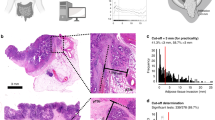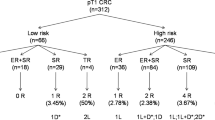Abstract
Colorectal carcinomas (CRCs) infiltrating through the muscularis propria layer without infiltration of adjacent structures, organs or the serosa—i.e. the pT3 tumors, compose the largest subset of large intestinal carcinomas treated by surgical resection. They are heterogeneous in terms of prognosis. CRCs treated by surgery in a period of 69 months were prospectively classified as pT3a tumors (invading to a maximum of 5 mm beyond the muscularis propria) and pT3b tumors (invading deeper). Their nodal status, incidence of vascular invasion and the presence or absence of distant metastases were analyzed in relation to the depth of invasion. Of the 593 CRCs primarily treated by surgery 429 were pT3 tumors. CRCs categorized as pT3a had significantly lower rates of nodal involvement (44% vs 75%), massive nodal involvement (pN2) (9% vs 39%), venous invasion (17% vs 30%) and distant metastasis (11% vs 28%) than pT3b tumors. Significant differences in these prognostic variables in pT3a and pT3b cancers were observed both for carcinomas of the colon and those of the rectum. Such differences were not obvious in further 66 ypT3 cases of rectal carcinoma receiving neoadjuvant treatment before surgery. Tumors in the pT3a category are associated with a better prognostic profile than pT3b tumors. This subdivision might be useful in both prognostication and treatment planning.
Similar content being viewed by others
References
Cserni G (2003) Nodal staging of colorectal carcinomas and sentinel nodes. J Clin Pathol 56:327–335
Sobin LH, Wittekind C (eds) (2002) UICC TNM classification of malignant tumours, 6th edition. John Wiley and Sons Inc., New York
Greene FL, Page DL, Fleming ID, et al (eds) (2002) AJCC Cancer Staging Handbook—TNM Classification of Malignant Tumors, 6th edition. Springer Verlag, New York
Heinzerling JH, Anthony T, Livingston EH (et al) (2007) Predictors of distant metastasis and mortality in patients with stage II colorectal cancer. Am Surg 73:230–238
Ricciardi R, Madoff RD, Rothenberger DA (et al) (2006) Population-based analyses of lymph node metastases in colorectal cancer. Clin Gastroenterol Hepatol 4:1522–1527
Abdulkader M, Abdulla K, Rakha E (et al) (2006) Routine elastic staining assists detection of vascular invasion in colorectal cancer. Histopathology 49:487–492
Wong SK, Jalaludin BB, Henderson CJ (2008) Direct tumor invasion in colon cancer: correlation with tumor spread and survival. Dis Colon Rectum 51:1331–1338
Adachi Y, Inomata M, Kakisako K (1999) Histopathologic characteristics of colorectal cancer with liver metastasis. Dis Colon Rectum 42:1053–1056
Cserni G, Vajda K, Tarján M (et al) (1999) Nodal staging of colorectal carcinomas from quantitative and qualitative aspects. Can lymphatic mapping help staging? Pathol Oncol Res 5:291–296
Wittekind C, Greene FL, Henson DE (eds) (2003) TNM Supplement: a Commentary on Uniform Use. 3rd edn. Wiley-Liss, New York
Compton CC, Greene FL (2004) The staging of colorectal cancer: 2004 and beyond. CA Cancer J Clin 54:295–308
Lowry R (2008) VassarStats. http://faculty.vassar.edu/lowry/VassarStats.html Cited 11 Jul 2008
Cawthorn SJ, Parums DV, Gibbs NM (et al) (1990) Extent of mesorectal spread and involvement of lateral resection margin as prognostic factors after surgery for rectal cancer. Lancet 335(8697):1055–1059
Willett CG, Badizadegan K, Ancukiewicz M (et al) (1999) Prognostic factors in stage T3N0 rectal cancer: do all patients require postoperative pelvic irradiation and chemotherapy? Dis Colon Rectum 42:167–173
Merkel S, Mansmann U, Siassi M (2001) The prognostic inhomogeneity of pT3 rectal carcinomas. Int J Colorectal Dis 16:298–304
Harewood GC, Kumar KS, Clain JE (2004) Clinical implications of quantification of mesorectal tumor invasion by endoscopic ultrasound: All T3 rectal cancers are not equal. J Gastroenterol Hepatol 19:750–755
Scott N, Thorne C, Jayne D (2004) Lymph node retrieval after neoadjuvant radiotherapy for rectal adenocarcinoma. J Clin Pathol 57:335–336
Author information
Authors and Affiliations
Corresponding author
Rights and permissions
About this article
Cite this article
Bori, R., Sejben, I., Svébis, M. et al. Heterogeneity of pT3 Colorectal Carcinomas According to the Depth of Invasion. Pathol. Oncol. Res. 15, 527–532 (2009). https://doi.org/10.1007/s12253-009-9149-x
Received:
Accepted:
Published:
Issue Date:
DOI: https://doi.org/10.1007/s12253-009-9149-x




